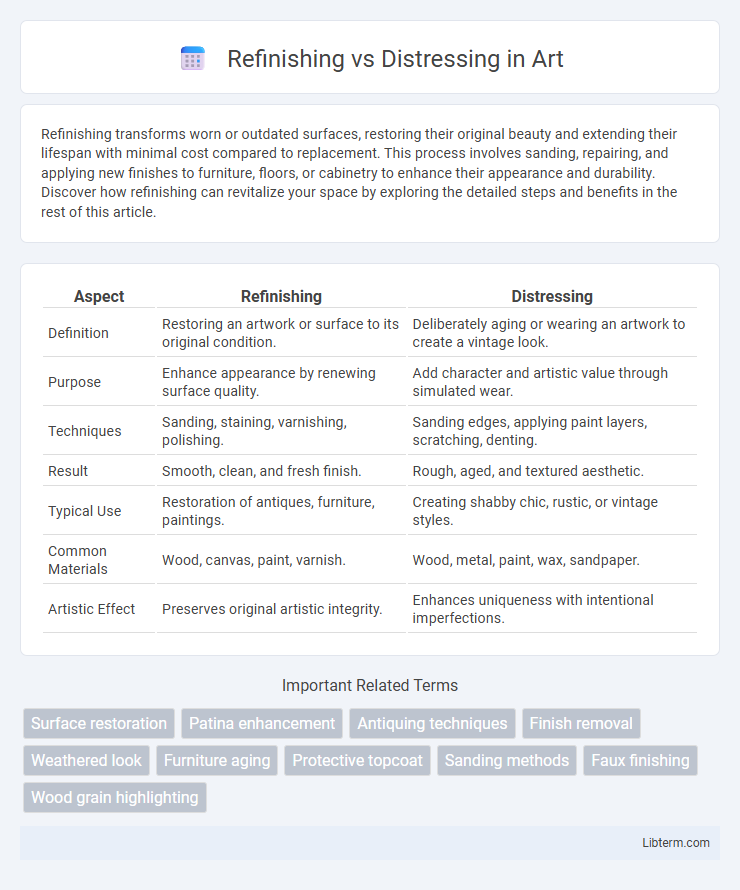Refinishing transforms worn or outdated surfaces, restoring their original beauty and extending their lifespan with minimal cost compared to replacement. This process involves sanding, repairing, and applying new finishes to furniture, floors, or cabinetry to enhance their appearance and durability. Discover how refinishing can revitalize your space by exploring the detailed steps and benefits in the rest of this article.
Table of Comparison
| Aspect | Refinishing | Distressing |
|---|---|---|
| Definition | Restoring an artwork or surface to its original condition. | Deliberately aging or wearing an artwork to create a vintage look. |
| Purpose | Enhance appearance by renewing surface quality. | Add character and artistic value through simulated wear. |
| Techniques | Sanding, staining, varnishing, polishing. | Sanding edges, applying paint layers, scratching, denting. |
| Result | Smooth, clean, and fresh finish. | Rough, aged, and textured aesthetic. |
| Typical Use | Restoration of antiques, furniture, paintings. | Creating shabby chic, rustic, or vintage styles. |
| Common Materials | Wood, canvas, paint, varnish. | Wood, metal, paint, wax, sandpaper. |
| Artistic Effect | Preserves original artistic integrity. | Enhances uniqueness with intentional imperfections. |
Introduction to Wood Finishing Techniques
Refinishing wood involves stripping away old finishes and applying new stains or coatings to restore or enhance the surface's appearance, preserving the wood's natural texture and grain. Distressing intentionally creates signs of wear and aging, such as scratches, dents, and uneven coloring, to achieve a vintage or rustic aesthetic. Both techniques require knowledge of wood types, appropriate tools like sanders and brushes, and the selection of suitable finishes such as varnish, lacquer, or oil to achieve the desired durability and look.
What Is Refinishing?
Refinishing involves restoring furniture or surfaces by applying new coats of paint, varnish, or stain to improve appearance and durability, bypassing structural changes. This process highlights original wood grain and maintains the piece's integrity while extending its lifespan. Refinishing is ideal for salvaging antique wooden furniture or worn surfaces without compromising quality.
What Is Distressing?
Distressing is a furniture finishing technique designed to create an aged, weathered look by intentionally adding wear and imperfections such as scratches, dents, and faded paint. Unlike refinishing, which restores or updates the surface, distressing emphasizes character and rustic charm through controlled damage and vintage effects. This method is popular for achieving shabby chic or farmhouse styles that evoke authenticity and history.
Key Differences: Refinishing vs Distressing
Refinishing involves sanding down a surface to remove old finishes and applying new paint, stain, or sealant for a refreshed, polished appearance. Distressing intentionally creates a worn, aged look by adding marks, scratches, or fading to mimic natural wear and tear. Key differences between refinishing and distressing lie in their goals: refinishing aims for renewal and protection, while distressing embraces imperfection and vintage style.
Pros and Cons of Refinishing
Refinishing hardwood floors restores their original beauty by sanding away imperfections and applying fresh stain and sealant, enhancing durability and aesthetic appeal. Pros include a smooth, uniform surface, increased floor longevity, and the ability to change color or finish type; however, cons involve dust and odor during sanding, higher cost compared to distressing, and potential vulnerability to damage if not properly maintained. Refinishing is ideal for floors with deep scratches or wear but may not be suitable for delicate or intricately designed wood surfaces.
Pros and Cons of Distressing
Distressing furniture involves intentionally creating a worn, aged appearance that adds character and vintage charm to pieces, making them ideal for rustic or shabby chic decor styles. Pros of distressing include the ability to hide future wear and tear, minimal maintenance requirements, and the unique, personalized look it provides. However, cons include the potential to reduce furniture value, limited appeal for modern interiors, and the risk of overdoing the effect, which can result in an unattractive, overly damaged look.
Costs and Time Involved
Refinishing furniture typically costs between $200 and $1,000 depending on the size and type of wood, taking anywhere from a few days to two weeks to complete due to sanding, staining, and sealing processes. Distressing, which involves techniques to give furniture an aged or weathered look, generally costs less, averaging $100 to $500, and can be done more quickly, often within a day or two since it requires less extensive preparation. Homeowners and professionals weigh these factors carefully when choosing between refinishing and distressing to balance budget constraints with desired aesthetic outcomes.
Best Materials and Tools for Each Method
Refinishing wood surfaces requires high-quality sandpaper, wood stain, brushes, and a durable polyurethane finish to restore and protect the material effectively. Distressing wood involves tools such as wire brushes, chains, hammers, and specialized paint techniques to create an aged, rustic appearance with textured surfaces. Selecting top-grade materials tailored to each method ensures optimal results, with refinishing emphasizing smoothness and clarity, while distressing prioritizes character and authenticity.
Choosing the Right Technique for Your Project
Refinishing involves restoring furniture or surfaces to their original condition by sanding, staining, and sealing, providing a smooth, polished finish ideal for modern or classic styles. Distressing intentionally ages and adds character through techniques like sanding edges, creating dents, or applying paint layers, perfect for rustic, vintage, or shabby chic aesthetics. Selecting the right technique depends on your desired look, the piece's condition, and the intended environment, ensuring harmony between style and functionality.
Tips for Refinishing and Distressing Success
Refinishing furniture involves sanding, staining, and sealing to restore or change its appearance, while distressing purposely adds wear to achieve a vintage look. For refinishing success, always prepare the surface thoroughly by cleaning and sanding evenly, applying primer when necessary, and choosing high-quality paint or stain for durability. When distressing, focus on strategically sanding edges and corners, using tools like steel wool or chains to mimic natural wear, and sealing with a protective finish to preserve the aged effect.
Refinishing Infographic

 libterm.com
libterm.com